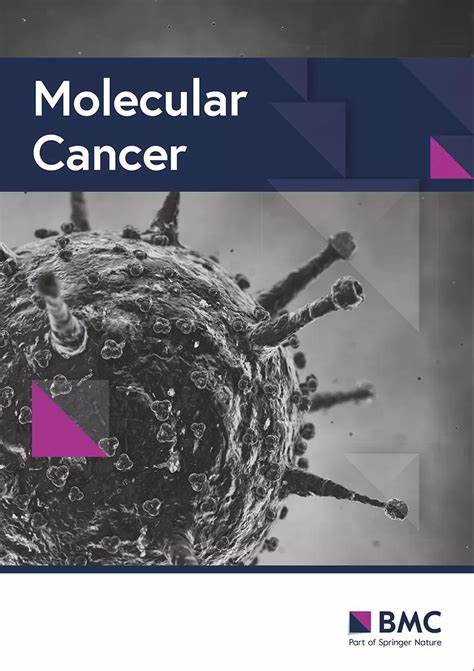CircERC1 facilitates chemoresistance through inhibiting pyroptosis and remodeling extracellular matrix in pancreatic cancer
IF 33.9
1区 医学
Q1 BIOCHEMISTRY & MOLECULAR BIOLOGY
引用次数: 0
Abstract
Pancreatic ductal adenocarcinoma (PDAC) resists to neoadjuvant treatment even though overall survival (OS) is transiently prolonged while the underlying mechanism of this drug resistance remains elusive. Gemcitabine combined with Nab-paclitaxel (GEM-NabP) treated PDAC tissues-derived EVs were isolated and underwent circRNA sequencing. CircERC1 was identified as an EVs-packaged circRNA that regulates PDAC progression and tumor microenvironment (TME) in vitro and in vivo with the help of EdU, colony formation, SRB viability assays, transwell assays and PET-CT analysis. The underlying mechanism was substantiated by qRT-PCR, Western blot, RNA pull-down, mass spectrometry, RNA immunoprecipitation and Co-immunoprecipitation. In addition, single-cell RNA sequencing was adopted to analyze the TME and immunohistochemistry, dual luciferase reporter assay were performed to validate the results. CircERC1 biogenesis is activated by QKI after GEM-NabP treatment. It interacts with hnRNPA1 and promotes its ubiquitination degradation by blocking its SUMOylation at K183. The degraded hnRNPA1 fails to upregulate PKM2, a crucial activator of NLRP3 inflammasome, thereby inhibiting Caspase1-GSDMD mediated pyroptosis. Furthermore, EVs-packaged circERC1 enhances extracellular matrix (ECM) deposition and hindering drug and immune cells infiltration in cancer associated fibroblasts (CAFs) in PDAC microenvironment. Our findings reveal a novel circERC1 as a key regulator in PDAC-secreted EVs following paclitaxel (PTX) treatment, thereby inhibiting gemcitabine/Nab-paclitaxel (GEM-NabP) induced pyroptosis. Our results highlight a potential therapeutic target for overcoming chemoresistance and remodeling pancreatic TME.CircERC1通过抑制胰腺癌的焦亡和重塑细胞外基质促进化疗耐药
胰腺导管腺癌(PDAC)抵抗新辅助治疗,即使总生存期(OS)短暂延长,但这种耐药性的潜在机制尚不清楚。分离吉西他滨联合nab -紫杉醇(GEM-NabP)处理的PDAC组织源性ev,并进行circRNA测序。在EdU、菌落形成、SRB活力测定、transwell测定和PET-CT分析的帮助下,CircERC1被鉴定为ev包装的circRNA,在体外和体内调节PDAC进展和肿瘤微环境(TME)。通过qRT-PCR、Western blot、RNA pull-down、质谱、RNA免疫沉淀和共免疫沉淀等方法证实了其潜在的机制。此外,采用单细胞RNA测序分析TME和免疫组织化学,双荧光素酶报告基因法验证结果。在GEM-NabP处理后,CircERC1的生物发生被QKI激活。它与hnRNPA1相互作用,并通过阻断其在K183的SUMOylation促进其泛素化降解。降解的hnRNPA1不能上调NLRP3炎性体的关键激活因子PKM2,从而抑制Caspase1-GSDMD介导的焦亡。此外,ev包装的circERC1增强了PDAC微环境中癌症相关成纤维细胞(CAFs)的细胞外基质(ECM)沉积,阻碍了药物和免疫细胞的浸润。我们的研究结果揭示了一种新的circERC1作为紫杉醇(PTX)治疗后pdac分泌的ev的关键调节因子,从而抑制吉西他滨/ nab -紫杉醇(GEM-NabP)诱导的焦亡。我们的研究结果强调了克服化疗耐药和重塑胰腺TME的潜在治疗靶点。
本文章由计算机程序翻译,如有差异,请以英文原文为准。
求助全文
约1分钟内获得全文
求助全文
来源期刊

Molecular Cancer
医学-生化与分子生物学
CiteScore
54.90
自引率
2.70%
发文量
224
审稿时长
2 months
期刊介绍:
Molecular Cancer is a platform that encourages the exchange of ideas and discoveries in the field of cancer research, particularly focusing on the molecular aspects. Our goal is to facilitate discussions and provide insights into various areas of cancer and related biomedical science. We welcome articles from basic, translational, and clinical research that contribute to the advancement of understanding, prevention, diagnosis, and treatment of cancer.
The scope of topics covered in Molecular Cancer is diverse and inclusive. These include, but are not limited to, cell and tumor biology, angiogenesis, utilizing animal models, understanding metastasis, exploring cancer antigens and the immune response, investigating cellular signaling and molecular biology, examining epidemiology, genetic and molecular profiling of cancer, identifying molecular targets, studying cancer stem cells, exploring DNA damage and repair mechanisms, analyzing cell cycle regulation, investigating apoptosis, exploring molecular virology, and evaluating vaccine and antibody-based cancer therapies.
Molecular Cancer serves as an important platform for sharing exciting discoveries in cancer-related research. It offers an unparalleled opportunity to communicate information to both specialists and the general public. The online presence of Molecular Cancer enables immediate publication of accepted articles and facilitates the presentation of large datasets and supplementary information. This ensures that new research is efficiently and rapidly disseminated to the scientific community.
 求助内容:
求助内容: 应助结果提醒方式:
应助结果提醒方式:


